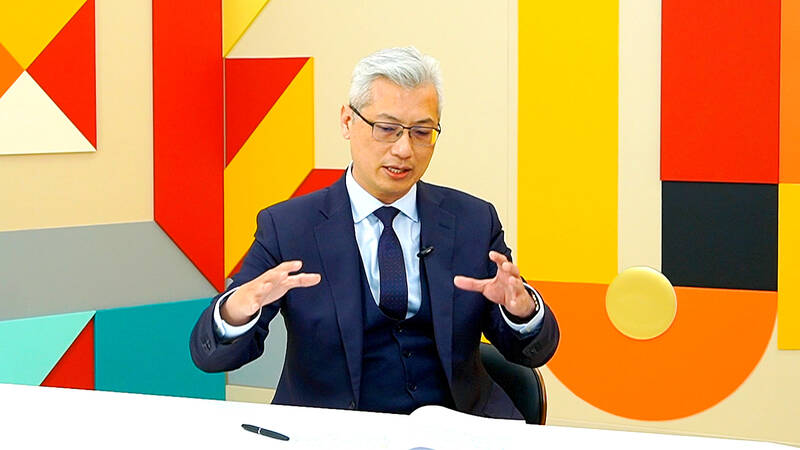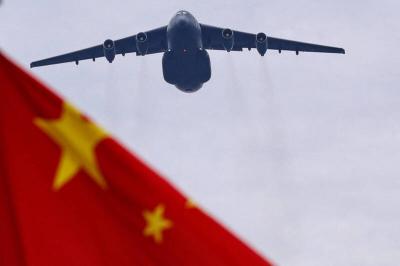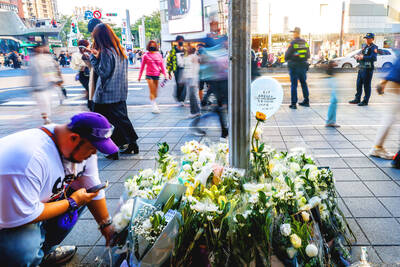The development of Taiwan’s wind power competitiveness should be on par with international standards following a 10-year policy that began in 2017, Ministry of Economic Affairs Industrial Development Administration Deputy Director-General Tsou Yu-hsin (鄒宇新) said.
Tsou made the remarks in an interview with the Liberty Times (sister paper of the Taipei Times) on Friday, citing government policies to support efforts to localize the wind power generation production chain since 2017, which are divided into three five-year stages.
Tsou said that localizing the production of wind power components would help the government attain its goals of using more green energy and developing Taiwanese green industries.

Photo: Liao Chia-ning, Taipei Times
We did not want to just import all equipment from the EU or other countries, which led to the decision to grow Taiwan’s green power generation and our industry, he added.
The government also wanted to expand Taiwan’s energy resilience, as fostering domestic production capabilities would ensure that repairs and maintenance would be less costly and more efficient, Tsou said.
Imagine if components had to be manufactured and shipped to Taiwan from abroad, the downtime — anywhere between three months to a year — would make Taiwan’s power generation less capable, he said.
The first five-year stage was dubbed the learning stage, during which the government inventoried domestic capabilities and isolated 20 items that Taiwan could manufacture domestically while matching international standards in terms of quality, price and speed, he said.
The initial stage was understandably challenging, because companies were expected to invest significant capital, introduce new technologies and train personnel to operate equipment, Tsou said.
The end product was expected to be compatible with international standards and immediately usable by wind power generation units, he said.
However, the government’s expectations that domestic companies would be able to completely manufacture all 20 items domestically within the first five-years were ultimately dashed, which made the second five-year stage — the “growing” stage — even more critical, Tsou said.
The nation has now entered the first and second phases of the third stage of wind power block development projects, he said.
During these projects, companies have been asked to grow their production capabilities and reduce overheads for production, with the expectation that by the conclusion of the “growing” stage, domestic companies would be able to meet international standards in terms of tech, quality, price and delivery times, Tsou said.
The third five-year stage, the “mature” stage, is to coincide with the 3-3 stage of wind power block development, which is the point at which government support would be gradually withdrawn, and the companies would be expected to establish their footing, not only in Asia, but also on the international stage, he said.

Beijing could eventually see a full amphibious invasion of Taiwan as the only "prudent" way to bring about unification, the US Department of Defense said in a newly released annual report to Congress. The Pentagon's "Annual Report to Congress: Military and Security Developments Involving the People's Republic of China 2025," was in many ways similar to last year’s report but reorganized the analysis of the options China has to take over Taiwan. Generally, according to the report, Chinese leaders view the People's Liberation Army's (PLA) capabilities for a Taiwan campaign as improving, but they remain uncertain about its readiness to successfully seize

HORROR STORIES: One victim recounted not realizing they had been stabbed and seeing people bleeding, while another recalled breaking down in tears after fleeing A man on Friday died after he tried to fight the knife-wielding suspect who went on a stabbing spree near two of Taipei’s busiest metro stations, Taipei Mayor Chiang Wan-an (蔣萬安) said. The 57-year-old man, identified by his family name, Yu (余), encountered the suspect at Exit M7 of Taipei Main Station and immediately tried to stop him, but was fatally wounded and later died, Chiang said, calling the incident “heartbreaking.” Yu’s family would receive at least NT$5 million (US$158,584) in compensation through the Taipei Rapid Transit Corp’s (TRTC) insurance coverage, he said after convening an emergency security response meeting yesterday morning. National

Taiwan has overtaken South Korea this year in per capita income for the first time in 23 years, IMF data showed. Per capita income is a nation’s GDP divided by the total population, used to compare average wealth levels across countries. Taiwan also beat Japan this year on per capita income, after surpassing it for the first time last year, US magazine Newsweek reported yesterday. Across Asia, Taiwan ranked fourth for per capita income at US$37,827 this year due to sustained economic growth, the report said. In the top three spots were Singapore, Macau and Hong Kong, it said. South

Taiwan is getting a day off on Christmas for the first time in 25 years. The change comes after opposition parties passed a law earlier this year to add or restore five public holidays, including Constitution Day, which falls on today, Dec. 25. The day marks the 1947 adoption of the constitution of the Republic of China, as the government in Taipei is formally known. Back then the Chinese Nationalist Party (KMT) governed China from Nanjing. When the KMT, now an opposition party in Taiwan, passed the legislation on holidays, it said that they would help “commemorate the history of national development.” That